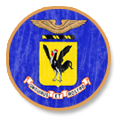45,000 Combat Missions for the 18th
On July 9, 1952, aA four-ship flight of the 67th FBS “returning from a close support mission landed at K-46 airbase. The fourth airplane of the flight completed the 45,000th effective combat sorties of the 18th Fighter Bomber Group, six days short of two years of combat flying in the Korean conflict. This number of sorties was the greatest among completed by any combat fighter bomber wing in Korea.” Captain Elliot Ayer, How Flight Leader, was credited with the 45,000th combat sortie.
Twilight Reconnaissance of Main Supply Route
It was nearly dark at 1915 hours on 25 July 1952, when Captain Ayer, Flight Leader of Filter How Flight was “wheels up” from K-46-Hoengsong, SK–on a twilight reconnaissance of a North Korean MSR. “The road was covered along its entire route by a considerable layer of clouds,” reported 1st Lt. C. J. Gossett.
“When we reached the beginning of our reconnaissance route, the Flight Leader told us that we would go to the East Coast [Wonsan Harbor area] and try to locate any enemy vehicles that might be in that area, since the coast was free of cloud layers.”
“Upon reaching the northern end of the prebriefed target at 1952 hours Captain Ayer elected to turn due East and seek a target of opportunity as the prebriefed area was under a solid overcast to as low as 3,000 feet,” 1st Lt. William McShane reported.
“Our briefed MSR was completely overcast,” noted 1st Lt. Baldwin, “so Captain Ayer led us East to Wonson Harbor area where the weather was clear. On approaching the Harbor, Lt. McShane called out some trucks traveling South on the MSR out of Wonson.”
“At Charlie Uncle 6518 with 1/10 clouds, McShane, “informed the Flight Leader of numerous vehicles on the MSR directly beneath us when he acknowledged. He then directed Number Three and Four in the flight to remain at 8,500 feet as top cover and informed me that we would make one pass only firing rockets and bombs.”
[Note: CU 6418 is approximately one mile north of Nam Sanyong-ni, NK.]
Soon after the Mustangs changed course, “the number two man saw several trucks.” The flight was at about 9,000 feet, when Ayer told the Numbers 3 and 4 planes “to remain at their altitude and orbit the area, while he and No. Two made their bomb run. When I last saw the leader his altitude was probably 6,000 feet,” Gossett noted.
“The leader called out he was going in and about ½ minute later the Number Two man called going in. It was approximately 2000 at the time [nearly dark] and objects were fairly hard to detect,” recalled Baldwin.
At 2000, Captain Ayer began an overhead pass “to roll out parallel with the road heading North. As he commenced his dive I informed him that his running lights were on and immediately thereafter lost sight of him for a few seconds as he went under a small cloud.” As McShane “lined up” on four trucks in a very shallow bomb run he “caught a brief glimpse of the Leader crossing my flight path at about 3,000 feet at a 10 degree angle some distance ahead and due to this I didn’t fire my guns or rockets, but continued on and as I dropped my bombs at about 1,000 feet, several automatic weapons commenced firing from directly ahead and to the left. Their fire appeared very accurate and continued until I had reached approximately 8,000 feet. At this time I called the Flight Leader at least six times requesting his position, but upon receiving no answer proceeded to join with Number Three and Four and circle the target area. Number Three informed me that he had seen what appeared to be a secondary explosion at approximately the above stated coordinates.”
“Shortly after losing sight of Number One and Two,” Gossett observed “a large quantity of flak in the area in which they were last headed. I observed a large explosion about one or two miles North of where Number Two dropped his bombs. At the time it reminded me of a napalm tank explosion. I do not know whether it was the explosion of the leader’s bombs, whether he got a secondary explosion from one of the trucks, or whether it was the leader’s airplane. Number Four and I continued to orbit the area, trying to establish either radio or visual contact with Number One and Two. After some time Number Two joined us. We then tried several times to contact How Leader.”
© Copyright 2015-2018 BelleAire Press, LLC
Next: Last Mustang Pilot of the 18th FBW KIA
 Truckbusters
Truckbusters 